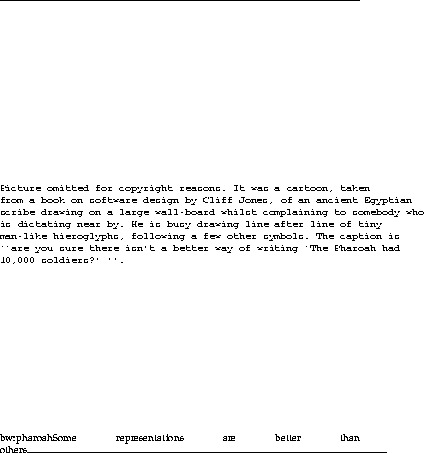
As I hinted earlier, I'm using PopBeast to demonstrate representations. An important idea in AI is that the same information can be represented in many different ways. There's an analogy with chemistry here. How does diamond differ from graphite? Graphite is soft enough for pencil leads; it's opaque, it's a good conductor of electricity, and (as charcoal) it makes an excellent fuel. Diamond is the hardest natural substance known; it's transparent, it doesn't conduct electricity, and not even the most desparate barbecue fanatic would throw his wife's wedding ring into the coals. Yet both are made from the same atoms.
The difference is form. In graphite, the atoms are arranged in layers that slip easily over one another, allowing the free passage of electrons, and coming off in streaks onto paper. In diamond, the atoms form a tetrahedral structure; it has no ``give'', and you must work very hard to detach an atom.
This is obvious to any chemist. But until 1860 or so, the difference was inexplicable. Although Dalton had put the idea of atoms combining in definite ratios, the notion of shape and arrangement of atoms was missing; no-one seems to have considered it until Van't Hoff proposed that carbon atoms have a definite shape, with bonds pointing outwards as from the centre of a tetrahedron.
Information has form as well. Programmers know that the same piece of information can be represented in many different ways: numbers in base 10, base 2, or as Roman numerals; dates as day/month/year or as days since January 1st 1890; images as arrays of intensity points or as a set of classified objects; geometric facts as drawings on graphs or co-ordinate equations ....
These choices are not arbitrary. The way something is represented on a particular information-processing system crucially affects the types of operation we can perform naturally and quickly (Figure 3). For instance, if we represent dates as days since a base date, it's easy to find the time between two dates, but hard to tell which month any date falls into. With the day/month/year representation, the converse is true.

So representation should be a crucial idea in psychology. But until the advent of computational models it has been largely neglected. What made us realise its importance was the technical difficulty of programming computers. Pages 24-33 of Artificial Intelligence by Winston (2nd edition) give an excellent example of different representations in an early analogy-solving program.